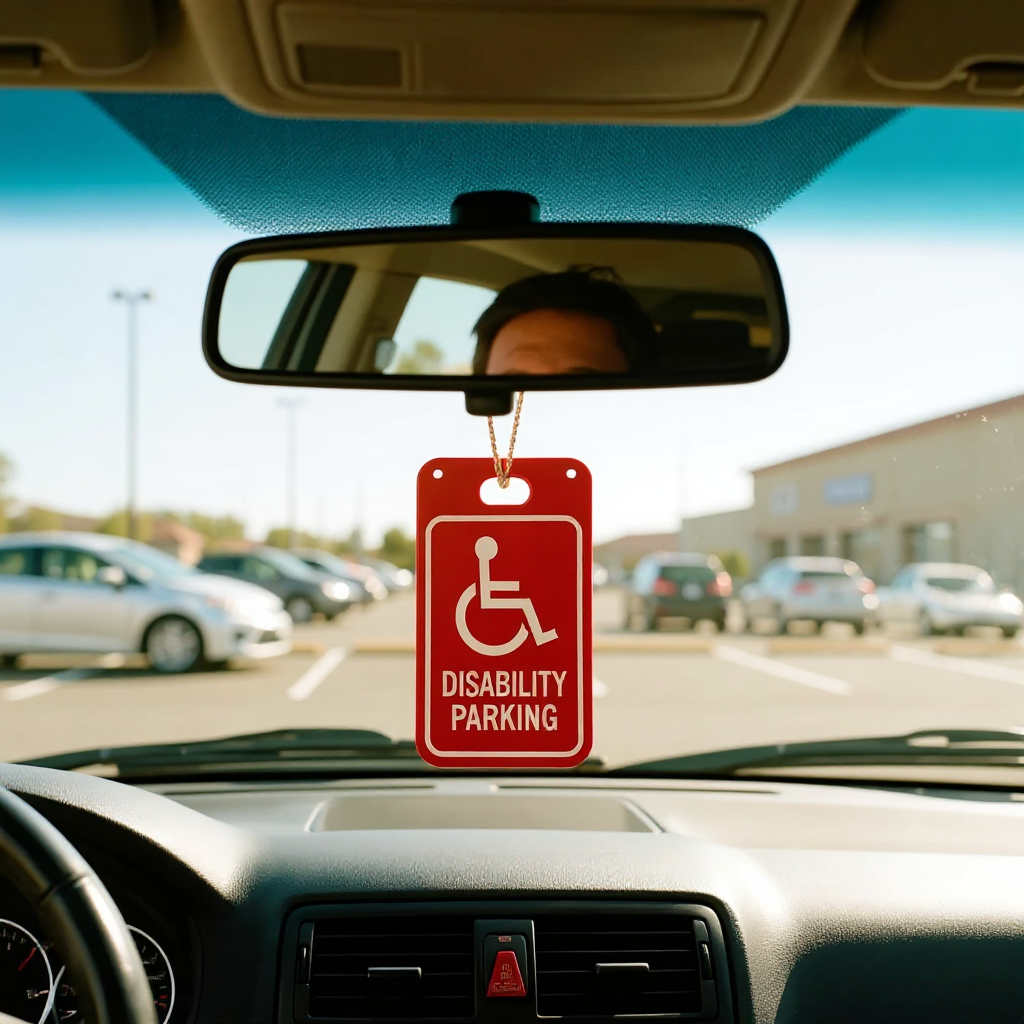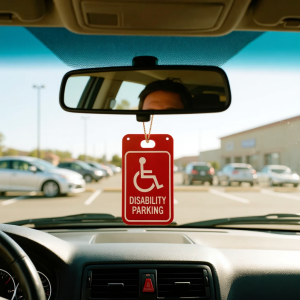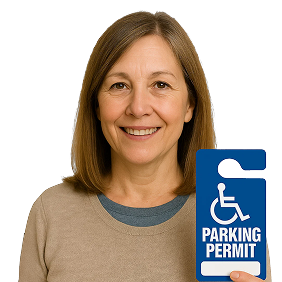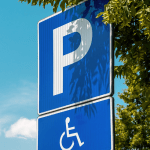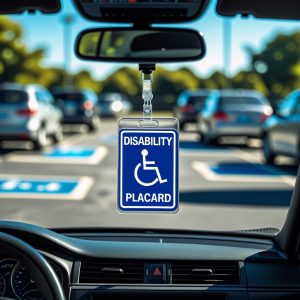According to the Centers for Disease Control and Prevention, 70 million Americans live with functional disabilities, many of them temporary conditions requiring short-term mobility assistance. If you’re recovering from surgery, managing an injury, or dealing with pregnancy complications, a red handicap parking permit provides essential parking relief when you need it most.
Red handicap parking permits offer the same parking privileges as permanent blue permits but are specifically designed for temporary mobility limitations. These permits ensure you can focus on recovery instead of struggling to find accessible parking during your most vulnerable time.
Many find the disability parking permit process confusing. Understanding who qualifies, how to apply, and proper usage rules can be challenging. This confusion often causes permit delays or accidental misuse that may lead to fines.
Understanding Red Handicap Parking Permits
This guide simplifies everything you need to know about red handicap parking permits. We cover the basics to help you get proper parking access quickly and legally.
We’ll guide you on how to apply for a temporary disability parking permit, qualifying conditions, fee structure, renewal timeline, and how to properly use your red placard. Let’s start by looking at what makes red handicap parking permits different from other disability parking passes.
What Are Red Handicap Parking Permits?
Red handicap parking permits are temporary disability placards issued by state DMVs for people with short-term mobility impairments. Unlike permanent blue permits, red permits have specific expiration dates aligned with your expected recovery timeline.
Key features of red permits:
- Access to all designated handicap spaces nationwide
- Parking meter exemptions in most locations
- Extended time limits at many parking areas
- Transferable between vehicles when the disabled person is present
The permits provide identical parking privileges to permanent permits but are designed for conditions expected to improve within 6 months to 1 year.
Red Permit vs. Other Colors
Different permit colors indicate specific uses, such as:
• Red = temporary disability
• Blue = permanent disability
• Green = veteran with disability (in some states)
• Purple = transportation vehicles (in some states)
Red permits offer several advantages for temporary needs. They have a faster approval process and require less paperwork than permanent permits. The shorter wait times help people get assistance quickly when they need it most.
Eligibility Requirements for Red Handicap Parking Permits
Medical Conditions That Qualify
To qualify for a red handicap parking permit, you must have one or more of these medical conditions:
- Limited ability to walk 200 feet without rest
- Need for mobility devices (wheelchair, walker, crutches)
- Severe lung disease or breathing difficulties
- Portable oxygen dependency
- Serious heart conditions affecting mobility
- Severe arthritis limiting movement
- Balance disorders impacting walking
- Vision impairments affecting safe walking
- Neurological conditions limiting movement
- Post-surgical recovery affecting mobility
- Pregnancy complications limiting mobility
These conditions significantly affect daily mobility and parking needs. For instance, Sarah from Texas received her permit after hip surgery that limited her walking to just 50 feet. Mike, recovering from cardiac surgery, needed his permit to attend frequent medical appointments without exhaustion.
Documentation Requirements
Getting your red handicap parking permit requires specific certification from medical professionals. Your doctor must verify your condition and explain why you need temporary parking accommodation. Understanding which medical conditions qualify for handicap permit approval can help determine if your situation meets state requirements.
State-by-State Cost of Red Parking Placards
Disability parking permit cost vary significantly across states, with many offering free or low-cost options to ensure accessibility during recovery. Here’s a brief breakdown:
| State | Temporary Permit Fee | Permanent Permit Fee |
|---|---|---|
| California | $6 | Free |
| Texas | $5 | Free |
| Florida | $15 | Free |
| New York | Free | Free |
| Illinois | Free | Free |
| Michigan | Free | Free |
| Virginia | $5 | Free |
| Louisiana | $3 | Free |
Several states provide permits at no cost. For example, California DMV offers free permanent permits, while New York DMV provides free permits for all types. Illinois and Michigan also offer free permits across all categories.
Low-cost states keep fees minimal. Texas DMV charges $5 for temporary permits, while Louisiana and Virginia maintain similar affordable rates.
Florida DHSMV charges $15 for temporary permits, covering administrative processing while remaining cheaper than daily parking fees at most medical facilities.
Veterans often qualify for fee waivers regardless of standard state fees. Some states offer discounts for low-income applicants, and second temporary permits issued within 12 months may be free in certain states.
How to Apply for a Temporary Disability Parking Permit in 2025
Step 1: Medical Certification
Schedule an appointment with your healthcare provider or telehealth services like ParkingMD to complete the medical certification section of your state’s application. They’ll assess your mobility limitations and provide an expected recovery timeline based on your specific condition.
Step 2: Complete Application
Download your state’s handicap parking permit application from the official DMV website. Complete all required sections with accurate personal information, including your driver’s license number and current address.
Step 3: Submit Documentation
Submit your completed application with medical certification to your state’s designated office. Many states now accept online submissions, eliminating the need for in-person visits during your recovery.
You’ll need a completed state application form, medical certification from a licensed healthcare provider, valid driver’s license or state ID, and application fee if applicable.
Processing Time for Red Handicap Permits
Most states process red handicap parking permit applications within 2-4 weeks of receiving complete documentation. However, processing times vary by state and application method.
Faster processing options:
- Online applications typically process 1-2 weeks faster than mail submissions
- In-person applications may provide same-day temporary permits in some states
- Complete documentation prevents delays from missing information requests
State examples:
- California: 2-4 weeks for mailed applications
- Texas: 1-3 weeks for complete applications
- Florida: 2-3 weeks typical processing time
- New York: 2-4 weeks depending on local issuing office
Some states provide temporary permits or receipts for immediate use while processing your permanent application. If you need parking accommodation urgently due to upcoming medical appointments, contact your state’s DMV to ask about expedited processing options.
Your Rights with Red Permits
Parking Privileges
Red permits grant access to designated handicap spaces marked with the International Symbol of Access. Most states provide meter exemptions, allowing free parking at parking meters, though you should verify local regulations. Many areas also offer extended time limits, exempting permit holders from standard parking restrictions.
The permit travels with you rather than staying with a specific vehicle. You can use it in any vehicle when you’re present, whether you’re driving or riding as a passenger.
Using Your Permit Correctly
Proper permit display and use is essential. Always hang it from your rearview mirror with the expiration date visible. Remove it while driving, and only use the permit when the authorized holder is in the vehicle.
For example, Sarah used her red permit during her 12-week recovery from a skiing accident. John relied on his permit for four months while healing from back surgery. Both found the permits essential for medical appointments and daily tasks.
Important Guidelines
Never let others borrow your permit. Check the expiration date regularly and remove it once you’ve recovered. Store the permit away from direct sunlight to prevent damage.
Red permits provide the same parking privileges as other permit colors. The only difference is their duration. All handicap permits must comply with Americans with Disabilities Act requirements.
Rules and Restrictions
- The permit holder must be present in the vehicle when using designated spaces.
- Never lend your permit to others or attempt to copy or alter it. If your permit becomes damaged, request a replacement immediately.
- Your permit allows parking in spaces marked with the wheelchair symbol, metered parking spots (check local regulations for fees), time-restricted zones, and access aisles adjacent to handicap spaces.
- The permit is valid across all 50 states. Always keep your permit ID card with you and report any loss or theft immediately. Check the expiration date monthly to ensure continued validity.
- Private property owners may enforce additional rules, while some cities impose time limits even with valid permits. Special events might alter normal parking regulations, and hospitals often maintain specific parking restrictions.
- To ensure your permit lasts, store it flat when not in use and keep it out of direct sunlight and extreme heat. Replace faded permits promptly to maintain visibility.
Following these guidelines helps preserve access for those who need these spaces. Remember that your red handicap parking permit is exclusively for your use – misuse can result in significant fines and reduce availability for others who depend on accessible parking.
Renewal and Replacement Procedures
Getting your red handicap parking permit renewed or replaced is a straightforward process when you know the steps to follow.
Renewal Process
Most red handicap parking permits expire within 6 months up to a year, and require a renewal if your disability persists. The expiration date is printed in large numbers on your permit. Start the renewal process 60 days before this date to avoid any gaps in coverage.
To renew your permit, you’ll need to visit your local DMV to complete the renewal form. A new doctor’s certification is required as part of the process. You’ll also need to submit your old permit and pay the renewal fee, which typically ranges from $10-30 in most states.
Many states now offer online renewal options, making the process more convenient. While some states send reminder letters, it’s best to track the expiration date yourself.
Lost or Stolen Permits
If your permit goes missing, you should immediately report stolen permits to local police. Next, visit your local DMV office where you’ll need to complete a replacement form. You’ll need to bring your ID and disability documentation. The replacement fee typically costs between $5-15 in most states.
The DMV will invalidate your old permit number for security. Never purchase used handicap placards online, as this is illegal.
Important Details:
• Temporary permits are available during processing
• Most states require new medical documentation
• Same-day replacements are often possible
• State rules vary for third-party pickup
Tom’s experience shows the process works: He lost his permit at a mall but received a replacement the next day by following these steps.
To maintain your permit properly, never use expired permits and keep your permit ID card separate from the placard itself. Track renewal dates carefully and contact your DMV if you have questions about the process.
Your red handicap parking permit provides essential access rights. Maintaining its validity ensures continuous access to accessible parking spaces.
When to Consider Permanent Permits
If your condition hasn’t improved after maximum renewal periods, most states require transitioning to a permanent blue permit. This prevents abuse of temporary permits for conditions that have become permanent or long-term in nature.
Summing up
Understanding the red handicap parking permit system helps people with mobility challenges find accessible parking. This guide covered the key aspects you need to know, from qualifying to using your permit correctly.
To begin the permit process, you’ll need to gather your medical records that show your qualifying condition. Next, complete the required DMV application form with your personal information. Your doctor will need to review and sign the medical certification portion to verify your need for the permit. Once you have all documents ready, submit your application along with any required fees to your local DMV office. After approval, you’ll receive your permit which must be properly displayed when parking.
Proper documentation from your doctor is vital when applying. Know the rules about where and how to use your permit. Keep track of when you need to renew to avoid gaps in your parking access.
Remember, your red handicap parking permit does more than make parking easier. It helps you stay independent and ensures fair access to public spaces for everyone in our community.
FAQs
What is the difference between red and blue handicap placards?
Red placards are temporary permits typically valid for 1-6 months and designed for short-term conditions like post-surgery recovery. Blue placards are permanent permits valid for 2-4 years and issued for long-term or permanent disabilities.
Why do placards come in different colors?
Different colors help parking enforcement officers quickly identify permit types and verify appropriate usage. Red indicates temporary needs, blue signifies permanent disability status, and some states also use green for special circumstances or white for organizational permits. This color-coding system makes enforcement more efficient and reduces permit misuse.
How many handicap placards can you get in Texas?
Texas typically allows 1-2 placards per person depending on your needs. For temporary permits, the state limits consecutive renewals to prevent long-term use when permanent permits would be more appropriate.
Can I transfer my handicap placard out of state?
Yes, handicap permits are recognized nationwide under reciprocity agreements between states. However, you must follow each state’s specific parking regulations, time limits, and local ordinances, which may differ from your home state.
How long can you park anywhere with a red handicap placard?
Parking time limits vary by state and location. In designated handicap spaces, most states allow unlimited parking time. At parking meters, California allows unlimited free parking, Florida provides 4 hours maximum free parking, and Texas exempts fees but requires following posted time limits unless local ordinances extend them.

